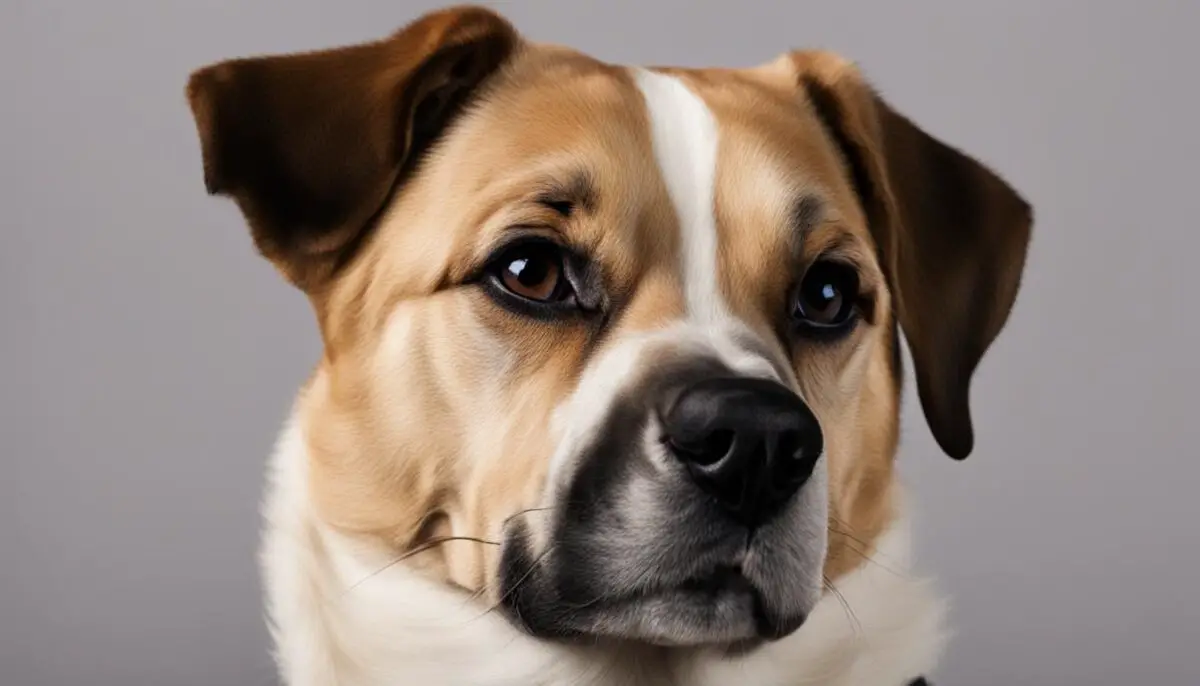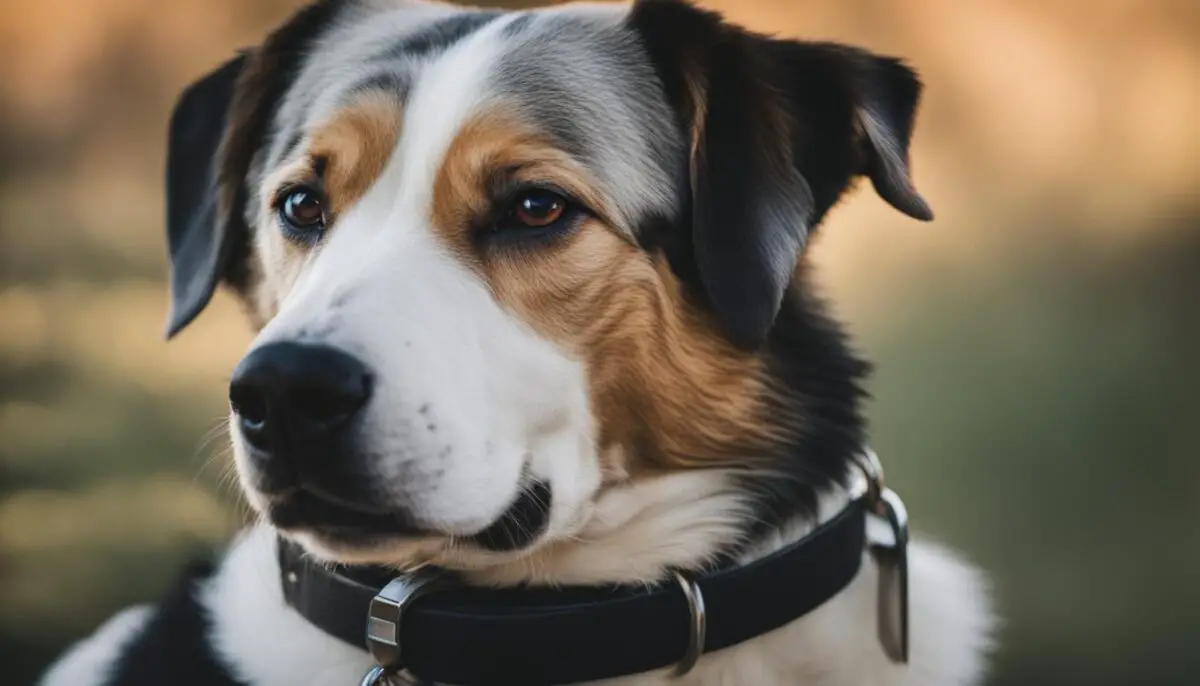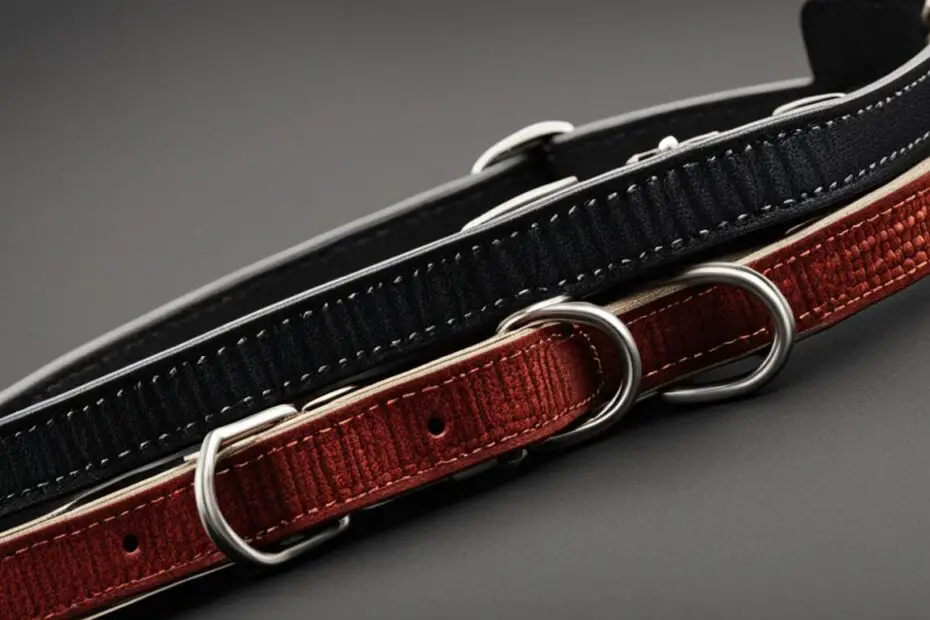When it comes to choosing a dog collar, thickness is an important factor to consider. The ideal collar thickness will depend on your pet’s size and strength. In this guide, we will provide you with helpful tips and information to help you select the right dog collar thickness for your furry friend.
Key Takeaways:
- Choosing the right dog collar thickness is essential for your pet’s comfort and safety.
- The thickness of a dog collar should be proportionate to your dog’s size and strength.
- Thicker collars are suitable for larger breeds or dogs that tend to pull, while thinner collars may be more comfortable for small dogs.
- Measure your dog’s neck to find the appropriate collar size using a flexible tape measure.
- Ensure a proper collar fit by adjusting the collar so that you can comfortably fit two fingers between the collar and your dog’s neck.
Understanding Collar Sizing
When it comes to dog collar sizes, one size doesn’t fit all. Different breeds have varying neck sizes, so measuring your dog’s neck is essential to find the right fit. Most pet brands provide a collar sizing chart that lists neck measurements and corresponding collar sizes. To measure your dog’s neck:
- Use a flexible tape measure.
- Wrap it around the widest part of your dog’s neck.
- Make sure the tape measure is snug but not too tight.
- Record the measurement.
Refer to the collar sizing chart provided by the manufacturer to determine the appropriate collar size for your dog.
Choosing the Right Thickness
The thickness of a dog collar plays a crucial role, especially when it comes to controlling and training your pet. It’s important to choose a thickness that is proportionate to your dog’s size and strength to ensure their comfort and safety.
Thicker collars for larger breeds: Larger breeds, such as Great Danes or Saint Bernards, require thicker collars to provide optimal control. These dogs have more strength and power, so a collar that measures between 1 to 1.5 inches in width is ideal. The wider width distributes the pulling force more evenly and reduces the risk of the collar breaking.
Thinner collars for small dogs: Small dogs, like Chihuahuas or Pomeranians, have delicate necks and require a collar that won’t overwhelm them. Opt for a thinner collar, around 0.5 to 0.75 inches wide. The narrower width ensures a comfortable fit without restricting their movement or causing discomfort.
Choosing the Right Thickness
| Dog Size | Ideal Collar Thickness |
|---|---|
| Large Breeds | 1 to 1.5 inches |
| Small Dogs | 0.5 to 0.75 inches |
When selecting a dog collar, keep in mind that both comfort and safety are paramount. A collar that is too thick for a small dog may cause discomfort and strain their neck, while a thin collar for a large breed may not provide adequate control. By choosing the right thickness, you can ensure your furry friend’s well-being and enjoy walks and training sessions together.

When it comes to your dog’s collar, the fit is crucial for both comfort and safety. A collar that is too tight can cause discomfort and breathing difficulties, while a collar that is too loose may result in your dog slipping out of it and getting lost. By following a few simple steps, you can ensure that your dog’s collar fits properly.
Measuring Your Dog’s Neck
The first step in ensuring a proper collar fit is to accurately measure your dog’s neck. Use a flexible tape measure and wrap it around the widest part of their neck. Make sure the tape measure is snug but not too tight. Take note of the measurement and refer to the size chart provided by the collar manufacturer.
“A properly fitting collar should be secure enough that the dog cannot slip out of it, yet loose enough to comfortably fit two fingers between the collar and the neck.”
– Dr. Jessica Smith, Veterinarian
Checking the Collar Fit
Once you have the collar, place it around your dog’s neck and fasten it securely. Check the fit by inserting two fingers between the collar and your dog’s neck. If you can easily insert two fingers, the collar is properly fitted. If it is too loose, adjust the collar’s length accordingly. If it is too tight, loosen it slightly. The goal is to achieve a comfortable and secure fit.
Regular Adjustments
Remember that a growing puppy may need their collar adjusted regularly as they develop. It’s important to check the fit of the collar periodically to ensure it remains comfortable and secure. Additionally, keep an eye out for any signs of discomfort such as rubbing or chafing on the neck. If you notice any issues, make the necessary adjustments or consider trying a different collar style or material.
Tips for a Proper Fit:
- Ensure the collar is snug but not too tight.
- Insert two fingers comfortably between the collar and your dog’s neck.
- Regularly check and adjust the collar as needed.
- Watch for signs of discomfort or irritation.
By taking the time to ensure a proper collar fit, you can provide your furry friend with a comfortable and safe accessory that allows them to enjoy their daily activities without restrictions.
| Issue | Incorrect Fit | Proper Fit |
|---|---|---|
| Too tight |  |
 |
| Too loose |  |
Adding ID Tags
One important aspect of keeping your furry friend safe is to ensure they wear proper identification at all times. Adding ID tags to your pet’s collar is a simple and effective way to provide crucial information in case your dog ever gets lost.
An ID tag typically includes your pet’s name, your contact number, and any other relevant information that can help someone identify and contact you as the owner. This includes your name and an alternative phone number, such as a family member or a trusted friend. The more contact information you provide, the better the chances of a safe and quick reunion with your beloved companion.
Here’s an example of what an ID tag might look like:
| Tag Information | Example |
|---|---|
| Pet’s Name | Max |
| Owner’s Name | John Doe |
| Contact Number | (555) 123-4567 |
By including accurate and up-to-date contact information, you increase the chances of a helpful individual reaching out to you if they find your lost pet. It’s always recommended to regularly check the engraved text on the ID tag to ensure it remains clear and legible over time. If the tag becomes worn or hard to read, consider replacing it to guarantee proper identification for your dog.
Remember, attaching ID tags to your pet’s collar is a small action that can have a big impact in keeping them safe. It provides peace of mind for pet owners and ensures a higher likelihood of a safe return if your furry friend ever wanders off.
Maintenance and Cleaning
Regular maintenance and cleaning are essential to keep your dog’s collar in optimal condition. By properly caring for the collar, you can ensure its longevity and your pet’s comfort. Whether you have a leather collar or one made from a different material, here are some guidelines to help you maintain and clean it:
- Cleaning Leather Collars: Leather collars can be easily cleaned with a damp cloth. Gently wipe the collar to remove any dirt or stains. If the collar has accumulated a lot of grime, you can use a mild soap or leather cleaner. After cleaning, make sure to thoroughly dry the collar to prevent any moisture from damaging the leather. Applying a leather conditioner periodically will also help keep the collar supple and prevent it from cracking or drying out.
- Checking for Wear and Tear: It’s important to inspect the collar regularly for any signs of wear and tear, especially if your dog is active or spends time outdoors. Look for any fraying, loose stitching, or damaged hardware. If you notice any issues, it’s best to replace the collar to ensure your pet’s safety and prevent any accidents.
- Caring for Other Collar Materials: If your dog’s collar is made from a material other than leather, such as nylon or fabric, follow the manufacturer’s instructions for cleaning and maintenance. Some collars may be machine washable, while others may require hand washing. Always check the care label or product information for specific cleaning guidelines.
Remember, a clean and well-maintained collar not only enhances your pet’s appearance but also contributes to their overall well-being. Now, let’s move on to the next section to learn more about adding ID tags to your dog’s collar.
Conclusion
Choosing the right dog collar thickness is crucial for the comfort and safety of your beloved pet. By taking into account factors such as collar sizing, thickness, materials, and proper fit, you can make an informed decision when selecting the perfect collar.
First, ensure you measure your dog’s neck using a flexible tape measure and refer to the manufacturer’s size chart to find the appropriate size. Next, consider the thickness of the collar based on your dog’s size and strength. Thicker collars, ranging from 1 to 1.5 inches wide, are suitable for larger breeds or dogs that tend to pull, while thinner collars, around 0.5 to 0.75 inches wide, may be more comfortable for smaller dogs.
Additionally, pay attention to the materials used in the collar. Leather collars are durable, classic, and easy to clean, while nylon collars offer affordability and a variety of styles and colors. Choose the material that best suits your pet’s needs and lifestyle.
Remember, achieving a proper fit is essential. The collar should be snug enough to prevent your dog from slipping out but loose enough to allow for comfortable breathing. Adjust the collar accordingly, ensuring you can comfortably fit two fingers between the collar and your dog’s neck.
By following this dog collar thickness guide, you can provide your pet with the comfort and safety they deserve. Regular maintenance and cleaning, including checking for wear and tear, will also help ensure the collar’s longevity. With the right collar, your furry friend will be ready for all your adventures together. Here’s to happy tail-wagging!
FAQ
How do I measure my dog’s neck to find the right collar size?
To measure your dog’s neck, use a flexible tape measure and wrap it around the widest part of their neck. Make sure it’s snug but not too tight, and record the measurement to refer to the size chart provided by the collar manufacturer.
What thickness should I choose for my dog’s collar?
The ideal thickness of a dog collar depends on your pet’s size and strength. Thicker collars, around 1 to 1.5 inches wide, are suitable for larger breeds or dogs that tend to pull. Thinner collars, approximately 0.5 to 0.75 inches wide, may be more comfortable for small dogs. Choose a thickness that is proportionate to your dog’s size and strength for their comfort and safety.
How do I ensure a proper fit for my dog’s collar?
The collar should be snug enough that your dog can’t slip out of it but loose enough to allow for comfortable breathing. You should be able to fit two fingers comfortably between the collar and your dog’s neck. Adjust the collar accordingly to achieve the proper fit.
Why should I attach ID tags to my dog’s collar?
ID tags are essential in case your dog ever gets lost. Make sure to include their name, your contact number, and any other relevant information. ID tags help others identify and contact you as the owner in case of an emergency or if your dog is found wandering.
How do I clean and maintain my dog’s collar?
Leather collars can be cleaned with a damp cloth and leather conditioner. Regularly check the collar for signs of wear and tear, especially if your dog is active. By properly maintaining and cleaning the collar, you can ensure its longevity and your pet’s comfort.
Why is choosing the right dog collar thickness important?
Choosing the right dog collar thickness is vital for your pet’s comfort and safety. The thickness should be proportionate to your dog’s size and strength. By considering factors such as collar sizing, thickness, materials, and proper fit, you can select the perfect collar for your furry friend.

